
After the smoke cleared on March 25, 1911, the sidewalks surrounding the Triangle Shirtwaist Factory were covered in blood. The coffined bodies of the 146 dead -- mostly Irish, Italian and Jewish factory workers -- lined the morgue pier. Firefighters found 14 engagement rings on the charred factory floor, where they had fallen from lifeless fingers.
Hours earlier all hell had broken loose. Menacing flames had engulfed the Asch Building on the corner of Greene Street and Washington Place in New York City. For the female workers on the top three floors, the building was a death trap. The scraps of fabric on the floor proved kindling, the locked doors morphed into oven doors, and the ninth and tenth floor windows became the only escape. Some workers fell to their death, others burned with the building and still others -- the lucky ones -- escaped down elevator shafts.
"Scenes of almost indescribable horror attended the catastrophe. Scores of girls leaped from windows eight, nine and ten stories above the street to their death. In one place so many bodies fell that the glass and iron deadlights in the pavement were broken," reported the New York Tribune the following day.
On the 100-year anniversary of the Triangle fire, the parallels between the struggles of the factory workers and the current labor disputes are evident. As America watches unions stand up against budget cuts, it hearkens to the event that sparked the initial union movement.
As of 1911, the Triangle fire was the greatest loss of life New York City had seen. Shocked and appalled, the American people turned to the press to interpret the disaster.
"Fire is a preventable phenomenon," wrote the New York Observer and Chronicle on April 13, 1911. "Men who in the match know how to bring together forces that can spring into light and flame when ignited know also how to put out the flames, or how to provide against the conditions which give rise to the violent spread of fire."
Outlook, a weekly magazine, said the disaster was caused by "civic indifference and inaction." Life Magazine blamed lax building code enforcement and corrupt building and factory owners.
Newspapers across the country printed graphic images of the fire, interviewing survivors and witnesses.
"The hundreds of girls and women in the room were pushing around and screaming wildly and many of them were jumping from the windows," survivor Samuel Lavine told the New York Tribune. "The smoke was by this time so thick that we could breathe only with difficulty."
In the months after the disaster, publications featured the "human stories" of the fire. Readers were introduced by name to the Triangle Shirtwaist Company's deceased factory girls in articles that emphasized the workers' perseverance in the face of poor working conditions and their heroism as their lives were taken prematurely.
"The wages were not so bad, [though] many of the girls only made $6 and $8 a week," said Rosey Safran, a survivor of the fire, to The Independent on April 20, 1911. "But they should have had some regard for our lives."
Historians credit the Triangle fire as one of the greatest stimuli for the labor and union movements of the twentieth century. Empowered by a sense of community, laborers stood up for shorter workdays, safer work conditions and higher salaries.
On October 1, 1912, The New York Times reported the recent passage of legislation limiting the workweek of women of boys to 54 hours was "a result of the agitation that followed the Triangle shirtwaist factory fire."
But the Triangle fire also proved an influential event in the history of journalism. Publications across the country banded together in defense of the defenseless. In the practice of the muckrakers of the early 1900s, they advocated openly for social change.
In the modern-day labor movement, protesters are standing up against the powers that control state budgets in the face of cuts to public sector unions. Around 150,000 people are currently picketing in Madison, Wisc. Thousands do the same in other states across the country. Their protest comes as a direct result of the action taken following the loss of the 146 lives in Triangle fire and of the media who worked to avenge them.
There has been emotional distance in the media's coverage of the current labor disputes. While stories about the protests have been featured in the country's newspapers, broadcasts and news websites, very few have delved into the human costs of the issues at hand. The "human stories" of these movements have been ignored.
Clearly, history repeats itself. But what remains to be seen is if today's media will heed the example of their predecessors and take a stand as the champion of the people.